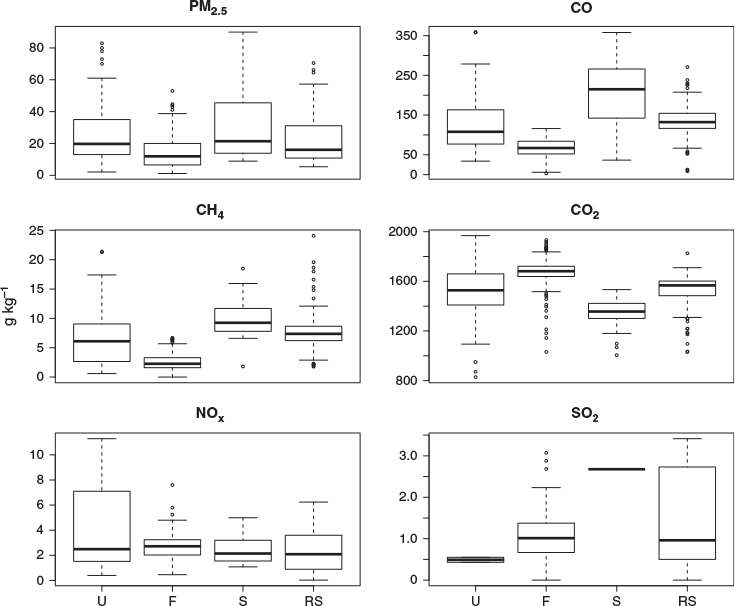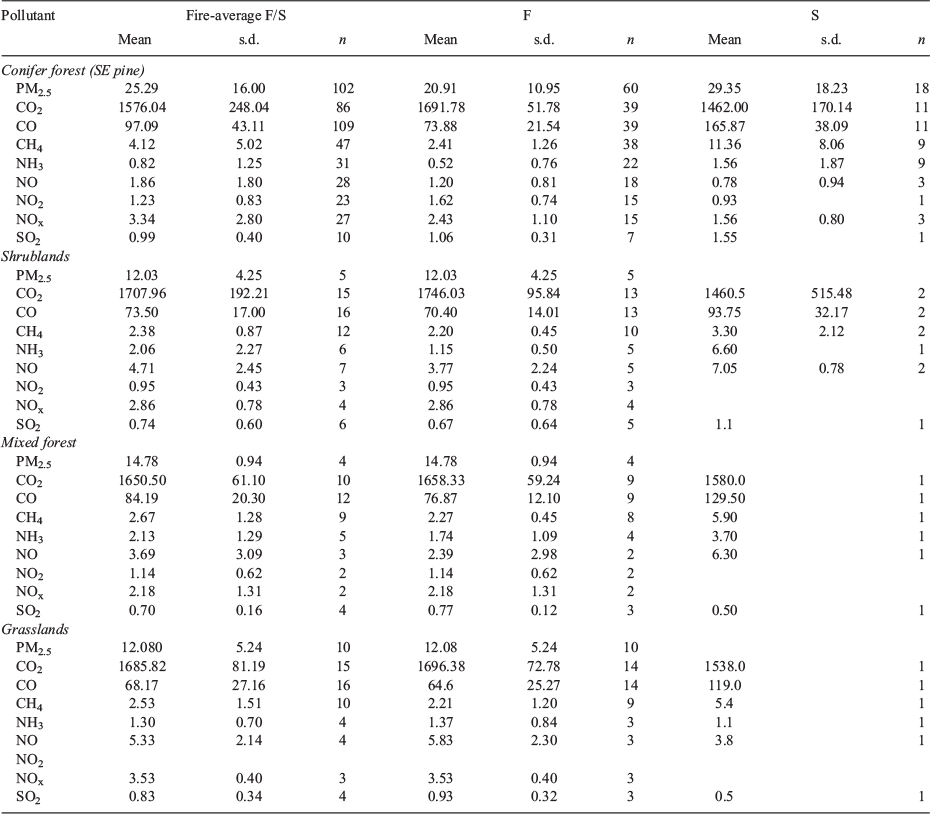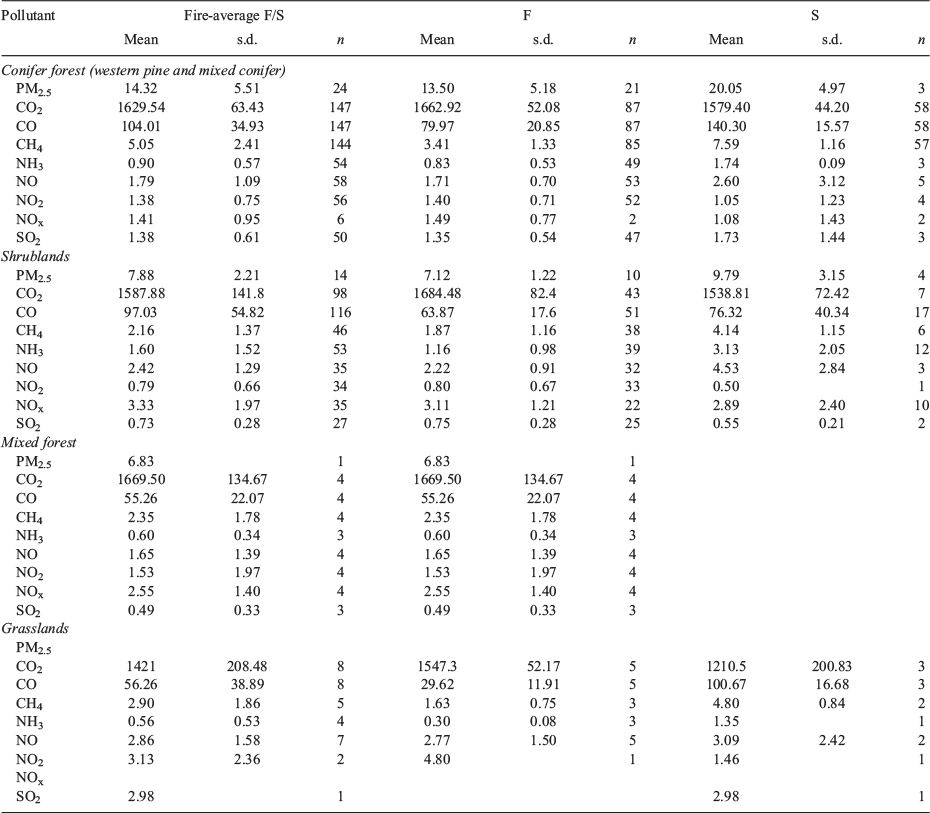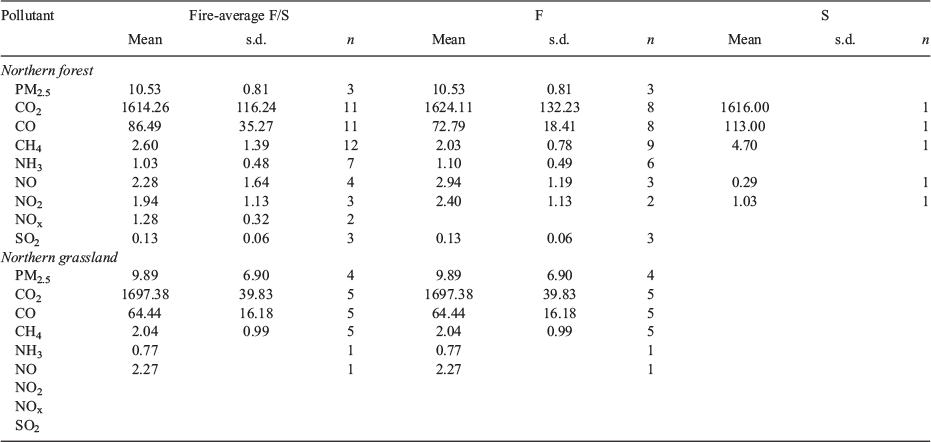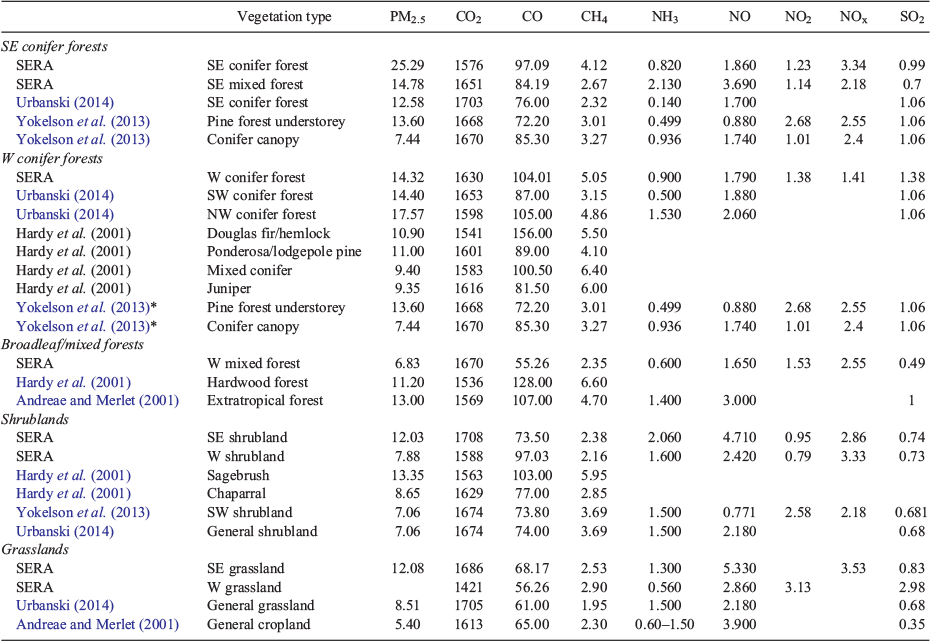Wildland fire emission factors in North America: synthesis of existing data, measurement needs and management applications
Susan J. Prichard A E , Susan M. O’Neill B , Paige Eagle A , Anne G. Andreu A , Brian Drye A , Joel Dubowy A , Shawn Urbanski C and Tara M. Strand DA University of Washington School of Environmental and Forest Sciences, Box 352100, Seattle, WA 98195-2100, USA.
B Pacific Wildland Fire Sciences Laboratory, US Forest Service Pacific Northwest Research Station, 400 N. 34th Street, Seattle, WA 98103, USA.
C Missoula Fire Sciences Laboratory, US Forest Service Rocky Mountain Research Station, 5775 W Broadway Street, Missoula, MT 59808, USA.
D Scion Research, Te Papa Tipu Innovation Park, 49 Sala Street, Rotorua 3010, Private Bag 3020, Rotorua 3046, New Zealand.
E Corresponding author. Email: sprich@uw.edu
International Journal of Wildland Fire 29(2) 132-147 https://doi.org/10.1071/WF19066
Submitted: 24 April 2019 Accepted: 26 October 2019 Published: 7 January 2020
Journal Compilation © IAWF 2020 Open Access CC BY-NC-ND
Abstract
Field and laboratory emission factors (EFs) of wildland fire emissions for 276 known air pollutants sampled across Canada and the US were compiled. An online database, the Smoke Emissions Repository Application (SERA), was created to enable analysis and summaries of existing EFs to be used in smoke management and emissions inventories. We evaluated how EFs of select pollutants (CO, CO2, CH4, NOx, total particulate matter (PM), PM2.5 and SO2) are influenced by combustion phase, burn type and fuel type. Of the 12 533 records in the database, over a third (n = 5637) are represented by 23 air pollutants, most designated as US Environmental Protection Agency criteria air pollutants, greenhouse gases, hazardous air pollutants or known air toxins. Among all pollutants in the database, including the most common pollutants PM, CO, CO2 and CH4, records are unevenly distributed with a bias towards flaming combustion, prescribed burning and laboratory measurements. Across all EFs, records are most common for south-eastern and western conifer forests and western shrubland types. Based on identified data gaps, we offer recommendations for future studies, including targeting underrepresented air pollutants, smouldering combustion phases and improved source characterisation of wildland fire emissions.
Additional keywords: air quality, greenhouse gas emissions, particulate matter, prescribed fire emissions, smoke management, wildfire emissions.
Introduction
Over the past decade, field and laboratory studies have made substantial progress in characterising the chemical composition of wildland fire smoke and quantifying emission factors (EFs) in North America. EFs are defined as the mass of a gas or aerosol pollutant per dry weight unit mass of consumed fuel (Urbanski 2014). Since the seminal review of Andreae and Merlet (2001), several reviews have summarised existing EFs by vegetation type or region (Akagi et al. 2011; Yokelson et al. 2013; Urbanski 2014), and studies were compiled into a summary dataset using unpublished and published data from the 1960s to 2011 (Lincoln et al. 2014). These developments, including several more recent studies, represent a large advancement in emissions characterisation and justify the creation of a master repository of EFs that can be used to produce consistent values applicable for wildland fire management, smoke modelling and emission inventories in North America.
The Smoke Emissions Repository Application (SERA) presented here is a searchable online database of existing EFs of 276 known air pollutants in standardised units (g kg−1) (https://depts.washington.edu/nwfire/sera, accessed 26 November 2019). EF records include modified combustion efficiency (MCE, Yokelson et al. 1996), fuel type, study type (laboratory or field), measurement platform (ground, tower or air-based), geographic location and source reference. The database was created to enable analysis and summaries of existing EFs, and creation of average EFs to be used in decision support tools for smoke management, including Consume (Prichard 2007), FOFEM (Reinhardt et al. 1997) and the BlueSky Smoke Modelling Framework (Larkin et al. 2009), as well as future updates to national emissions inventories (e.g. US EPA 2017). Prior to updates provided by Urbanski (2014), models that predict wildland fire emissions such as Consume, FOFEM and BlueSky used EFs published within the 2001 Smoke Management Guide (Hardy et al. 2001) and supported a relatively small list of pollutants, including particulate matter (PM), carbon monoxide (CO), carbon dioxide (CO2), methane (CH4), non-methane organic compounds (NMOCs) and sulfur dioxide (SO2). SERA was designed to provide a synthesis of existing EFs and summary values for emissions modelling that can facilitate more rapid incorporation of EFs than was previously available through a relational database maintained by the US Forest Service Pacific Wildland Fire Sciences Laboratory (Seattle, WA).
For many air pollutants, selecting the most appropriate EFs to represent emissions from biomass burning needs to consider the combustion of fuels that burn in smouldering combustion and low-heat pyrolysis phases (e.g. coarse wood and organic soils). Modified combustion efficiency (MCE = ΔCO2/(ΔCO2 + ΔCO)) is a measure of the relative fraction of flaming and smouldering combustion, and has been demonstrated to be highly correlated with EFs for pollutant emissions (such as CO, CH4 and NMOCs) that are more concentrated in smouldering combustion phases (Urbanski 2014). Emissions studies often include a measure of MCE to characterise source combustion phase (Yokelson et al. 1996; Urbanski 2014). For example, Urbanski (2013) found that Rocky Mountain wildfire emissions from prescribed fires in moderate to heavy coarse wood had a much lower MCE than that observed in studies of prescribed fires in the south-east, from where the majority of the EFs reported in the literature for NMOCs and PM2.5 have been derived. More recently, Sekimoto et al. (2018) examined relationships between high- and low-temperature pyrolysis and found that these two variables explained most of the variability in non-methane organic gas emissions and outperformed MCE. The relationship between wildland fire emissions and combustion highlights the need to develop algorithms for extrapolating EFs to broadly representative fuel types and burning conditions (e.g. flaming v. smouldering and prescribed underburn v. crown fire). Because many smoke management issues associated with wildland fire emissions are from residual long-term smouldering sources, characterising the fuels and EFs associated with these burning conditions is critical for fire management applications (Urbanski 2013; Yokelson et al. 2013; Hu et al. 2018; Peterson et al. 2018). Some studies also suggest that factors driving burning conditions including wind, fuel moisture and fire behaviour may more strongly influence pollutant emissions than differences in fuel type or region (Yokelson et al. 2013; Koss et al. 2018).
EFs are generally presented as best estimates, based on compiled datasets of either fire-average values (i.e. representing pollutant emissions from a combination of concurrent flaming and smouldering fuel consumption) or combustion phase (e.g. flaming, short-term smouldering and residual long-term smouldering). Flaming combustion is defined as high-temperature combustion in the presence of flames. Short-term smouldering combustion, hereafter referred to as smouldering combustion, occurs at lower temperatures without flames and is often associated with incomplete fuel combustion. Long-term residual smouldering is generally associated with marginally combustible fuels such as coarse wood (i.e. stumps and downed logs >7.6 cm in diameter) and duff that generally have incomplete combustion and smoulder for extended periods (Ottmar 2014).
Smoke management guides have traditionally summarised EFs by major vegetation or fuel type. For example, the 2001 Smoke Management Guide (Hardy et al. 2001) compiled pollutant EFs from existing studies of prescribed burns, including EFs summarised from broadcast burned slash of Douglas fir, juniper and ponderosa pine forests (Ward et al. 1989), broadcast burned brush (Hardy et al. 1996) and wildfires (Hardy et al. 1992). Hardy et al. (2001) also provided EFs by flaming, short-term smouldering and long-term residual smouldering phases of combustion. Summarising EFs by combustion phase is generally useful for fire managers to inform smoke reduction techniques, such as finding optimal burn windows that maximise flaming combustion and minimise long-term smouldering (MACTEC Federal Programs 2004), which can contribute to greater overall pollutant emissions of PM and CO and nighttime intrusions into communities (Miller et al. 2019).
Since the original smoke management guide was published in 2001, a large number of prescribed burn studies and a relatively small number of wildfire emissions studies have been conducted. Urbanski (2014) synthesised fire-average EFs for major pollutant species by burn type (i.e. prescribed burns and wildfires) and region and/or vegetation type. Fire-average flaming and smouldering EFs and their estimated uncertainty were summarised based on six prescribed fire groupings in the US, including south-eastern (SE) conifer, south-western (SW) conifer and north-western (NW) conifer forests, western shrublands and western grasslands, and two wildfire categories including W conifer wildfires and boreal wildfires. Additional residual smouldering EFs were included for coarse wood, temperate forest organic soils and boreal forest organic soils (referred to hereafter as duff). More recently, sampled plumes from western US wildfires suggest that the quantity and composition of fuels burned in summer (May–October) wildfires may substantially increase estimates of pollutant emissions, including greenhouse gases (e.g. CO2 and CH4) and particulate matter (Liu et al. 2017).
The objectives of this study were to develop a centralised repository for evaluating and synthesising emissions factor datasets for major fuel types in North America and to provide updates to best-estimate EFs for major pollutant species. Because wildland fire emissions research is a rapidly developing field, many additional studies have been conducted since the Wildland Fire Emissions Factor Database was released in 2014 (Lincoln et al. 2014) and the publication of best-estimate EFs by Urbanski (2014). In the present study, we introduce SERA, an online repository of wildland fire EFs and source references, and provide revised and summarised EFs that can be used for smoke management planning for wildland fire events. The web application provides the most complete compilation of wildland EFs to date and a searchable, online database. Using the large sample size for some pollutants, we evaluated how EFs are influenced by combustion phase, burn type and fuel type. We offer recommendations for future studies including targeting underrepresented air pollutants and the relative influence of fuel type, measurement platform and combustion phase on estimated pollutant emissions.
Methods
As part of a broader study on fire behaviour and emissions funded by the Strategic Environmental Research and Development Program (SERDP), Lincoln et al. (2014) compiled existing emissions factor data from the 1960s through ~2010 into annotated tables, with companion references available to download (https://www.fs.usda.gov/rds/archive/Product/RDS-2014-0012, accessed 26 November 2019). We converted the tabular dataset into a relational database and reviewed all source references to add greater attribution and correct input errors, including location, major vegetation type, MCE and/or combustion phase and burn type (e.g. laboratory, prescribed fire or wildfire and measurement platform). Each source reference was reviewed to ensure that the EF observation was fully attributed with fields defined in Table 1. Supported pollutants were assigned a molecular weight, common name, an International Union of Pure and Applied Chemistry database identification number and US Environmental Protection Agency (EPA) Substance Registry Services ID and pollutant category (SRS, https://ofmpub.epa.gov/sor_internet/registry/substreg/LandingPage.do, accessed 26 November 2019) to allow cross-referencing to other air quality and pollutant databases. Reported EF units were standardised to grams of pollutant per kilogram of dry weight biomass consumed (g kg−1). In many cases, EFs were converted from lb ton−1 to g kg−1or from g kg−1-C to g kg−1 if the study also reported the fuel carbon content. We did not attempt to convert emission ratio data into EFs. For each study, we added individual burn data as opposed to summary data. We also confirmed that all source records were original EF data and not duplicated in other studies. For records having a measured MCE, combustion phases were assigned as flaming (MCE ≥ 0.9), smouldering (MCE = 0.8 to <0.9) and residual smouldering (MCE <0.8) (after Akagi et al. 2011). In older records in which CE was reported instead of MCE, we either used the reported phase or same thresholds to assign combustion phase. Once the existing dataset was quality assured and standardised, we added records from recent published studies (2010–18). See Supplementary Appendix 1 for the list of references augmenting the Lincoln et al. (2014) work. Currently, there are 12 533 records in the database from 49 source references.
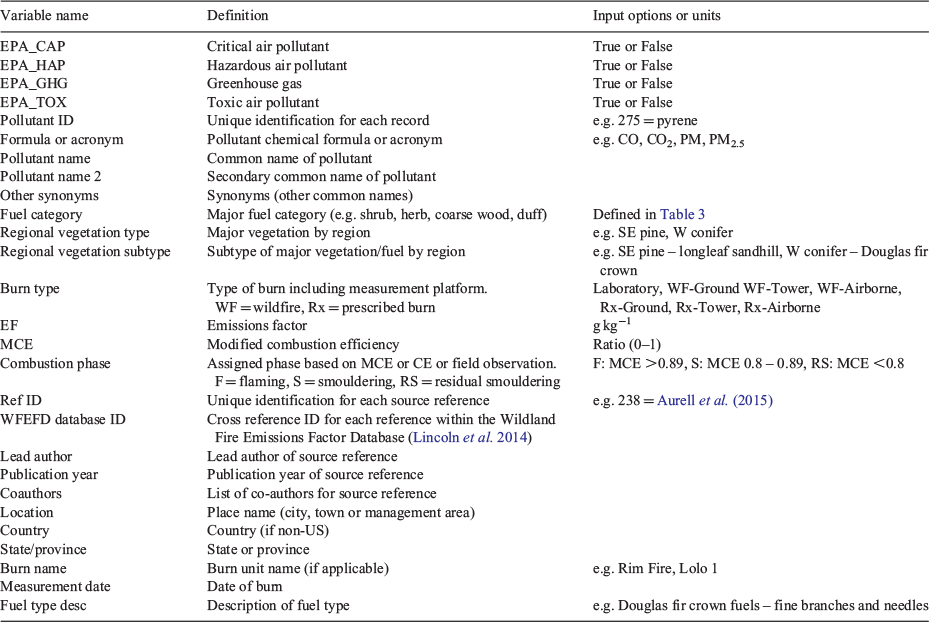
|
The goal of SERA was to compile available EF data into a single repository with ease of access to the data. In this sense, all records are treated equally. We did not attempt to identify whether one study might be better than another study. The online, searchable database makes it straightforward to lookup the original references, allowing users to customise data for their particular application.
Statistical analysis
To evaluate the influence of combustion phase, MCE, burn type and vegetation or fuel type on estimated EFs, we concentrated on major pollutants with sufficient record counts and of high relevancy to wildland fire planners and regulators: carbon dioxide (CO2); carbon monoxide (CO); methane (CH4); nitrogen oxides (NOx); particulate matter (PM2.5 and total PM); and sulfur dioxide (SO2).
Explanatory variables of EFs were evaluated using Analysis of Variance tests (R statistical programming, ANOVA) (R Studio, Supplementary Appendix 2). Tukey’s Honest Significant Difference testing was used to evaluate for significant differences among predictor categories (e.g. combustion phase, burn type or fuel type). Due to unequal distribution of records across predictor variables, one-way ANOVA tests were conducted for each variable and on subsets of pollutant emissions data with sufficient and comparable record counts. For example, combustion phase was evaluated as a potential predictor variable of CO2 EFs, but because few records were available for the residual smouldering (n < 10), only those records recorded as either flaming or smouldering were evaluated.
We evaluated how EFs vary by burn type, which is a combination of fire type (i.e. laboratory, prescribed fire and wildfire) and measurement platform (i.e. ground-based, tower and airborne) (Fig. 1). Due to imbalances in record counts within each burn type category, pollutant datasets were subset to exclude any burn types with insufficient record counts (n < 10).
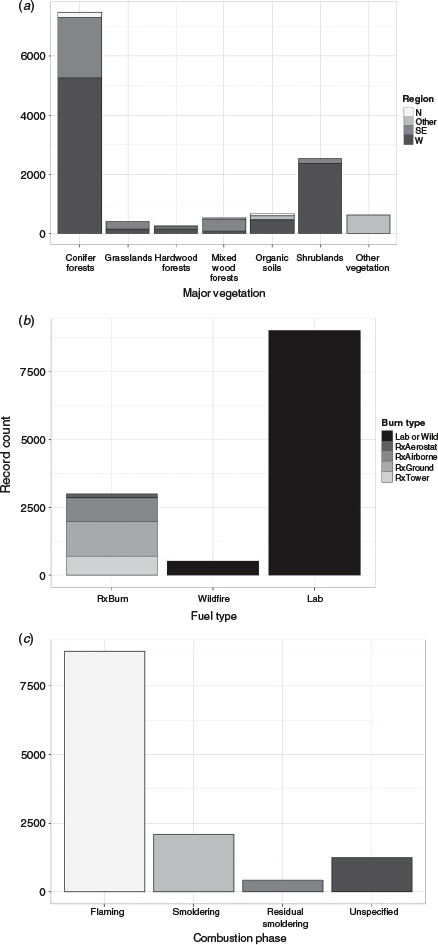
|
Because vegetation and/or fuel type are generally used to summarise and apply EFs in wildland fire management and emissions inventories, we evaluated regional vegetation type as an explanatory variable of EFs by major pollutant (Table 2). Regional vegetation types were first analysed, subsetting the dataset to exclude sparsely populated types; we also evaluated fuel category, which assigns a dominant fuel (e.g. grass, shrub, pine needles, organic soil) regardless of region for each EF record (also listed in Table 2). Fuel consumption is influenced by a range of factors, including mass of available fuel, fuel moisture, surface area-to-volume ratios, packing ratio and presence of volatile compounds (Ottmar 2014). In the absence of fuel moisture content data for each EF record, regional vegetation type may provide a surrogate for climatic differences in site moisture. In contrast, comparing EFs among fuel categories evaluates potential differences in inherent combustion properties, including differences in packing and surface area-to-volume ratios.
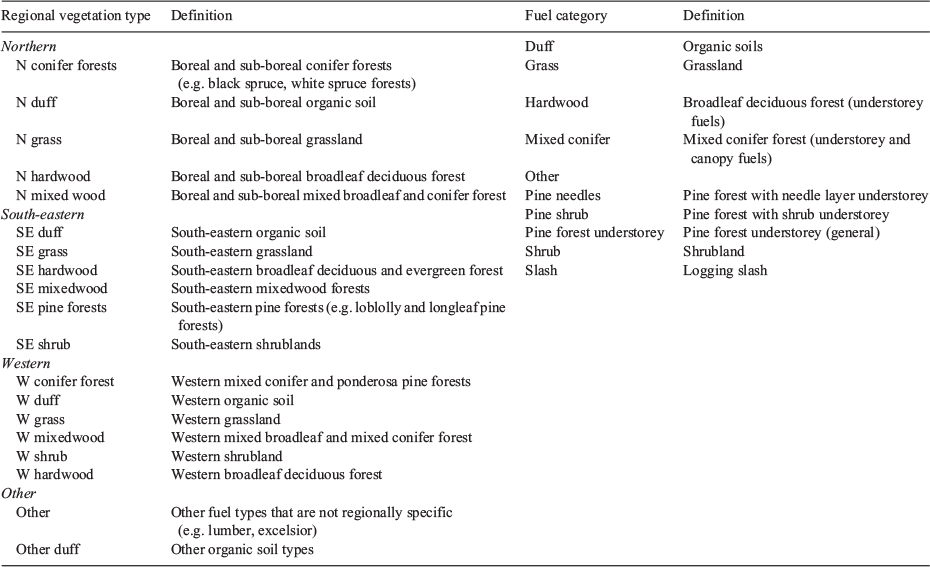
|
Sample application
To demonstrate how EFs can be used for prescribed burn planning, we used a dataset of prescribed understorey burns in SE and W conifer forests of the US that reported mean fuel consumption by major surface fuel category (Prichard et al. 2017). For PM2.5, we had sufficient records in SERA to calculate EFs specific to flaming and smouldering consumption in addition to a fire-average short-term flaming and smouldering EF. For fuel categories that contribute to long-term smouldering, we used the residual coarse wood EF of 33 g kg−1 and residual duff EF of 50 g kg−1, after Urbanski (2014). Currently, there are no empirical models to estimate consumption by combustion phase, and consumption was not reported by phase in Prichard et al. (2017). The two main operational consumption models in the US have different ways of allocating consumption into flaming v. smouldering consumption and making emissions factor assignments. Consume v 5.0 assumes a generic proportion for each fuel category (e.g. herbs, shrubs, 1-h wood, 1000-h wood, litter or duff) to partition consumption values in flaming, smouldering and residual consumption (Prichard 2007). In contrast, FOFEM uses the BURNUP model (Albini and Reinhardt 1997) to calculate intensity of the burn with a threshold of >15 kW m−2 representing flaming combustion and <15 kW m−2 representing smouldering combustion. For these sample calculations, we used Consume’s assumed proportional consumption by combustion phase to allocate the average fuel consumption reported for south-eastern forest and western ponderosa pine sites in Prichard et al. (2017) into flaming, smouldering and residual smouldering phases. Emissions by fuel category were then estimated by two methods – first by calculating flaming, smouldering and residual emissions by fuel category, and second by estimating total emissions using a fire-average EF. Variability in total emission estimates were also calculated using a single standard deviation of EF (±1 s.d.).
Results
Of the 12 533 records in the database, 45% (n = 5637) are represented by 23 air pollutants, most of which are designated as EPA criteria air pollutants (CAP), greenhouse gases (GHG), hazardous air pollutants (HAP) or known air toxins (TOX) (Table 3). A list of the 274 pollutants currently supported in the database, including record counts and summary statistics for EF and MCE, is available as an online appendix table (Supplementary Appendix 3). Among all pollutants in the database, including the most common pollutants (e.g. PM, CO, CO2 and CH4), records are unevenly distributed with a bias towards flaming combustion, prescribed burning and laboratory measurements. Overall, EF records are most common for SE and W conifer forests and W shrubland types of the US (Fig. 1). Considering EF records by fuel category, EF records are most numerous for western mixed conifer, south-eastern and western pine understorey fuels and western shrublands.
Carbon dioxide and carbon monoxide
CO2 and CO are well represented in the database, with a total of 578 and 640 records respectively, excluding outliers. Early emission studies did not generally record combustion phase (MCE or combustion efficiency, CE), and more than a quarter of records lack an assigned phase. Of the records with an assigned phase, around 50% of CO2 and CO EFs were sampled during flaming combustion. Although there is a positive relationship between CO2 and MCE, the relationship is weak (R2 = 0.4113, P < 0.0001, Fig. 2). There are significant differences in CO2 EFs among flaming, smouldering and residual smouldering combustion phases, with the highest EFs in flaming and lowest EFs in residual smouldering (Fig. 3).
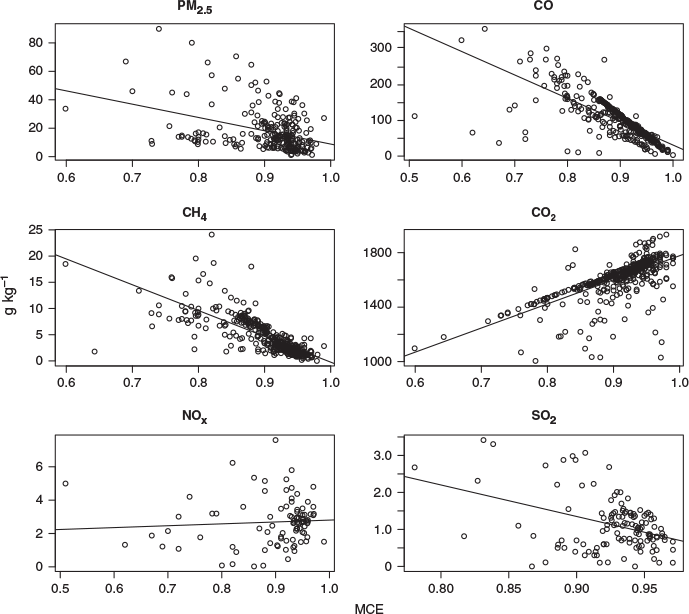
|
Regional vegetation type is not a strong predictor of CO2 EFs, with only a significant difference between SE shrub and SE pine CO2 EFs. Comparing fuel categories, duff EFs are significantly lower than most other categories (e.g. grass, mixed conifer, mixed wood, pine forest understorey, shrub and slash). Pine forest understorey EFs have a narrow range of observed values and are significantly higher than some other fuel categories (e.g. duff, slash, pine needles). When only flaming CO2 EFs are considered, no significant differences are found among fuel categories. However, when considering only smouldering CO2 EFs, duff EFs are significantly lower than mixed conifer and pine forest understorey fuels, and mixed conifer EFs are significantly higher than grass.
Among burn types (Laboratory, Rx-Air, Rx-Ground and WF-Air), laboratory CO2 EF values have the widest representation and range of observed values, with no significant difference among other burn types. Rx-Tower observations range widely but are significantly lower than Rx-Ground and WF-Air. When CO2 EFs are partitioned into flaming and smouldering combustion classes, no significant differences are found among burn types.
The CO EFs are significantly different among combustion phases, with highest and most variable CO EFs in the residual smouldering phase, moderate EFs in smouldering and lowest EFs in flaming combustion (Fig. 3). CO is negatively related to MCE (R2 = 0.6444, P < 0.0001, Fig. 2). Regional vegetation types and fuel categories are unevenly distributed among CO EFs. CO EFs are generally not statistically different among regional vegetation, with only significant differences between SE grass and W conifer. However, there are notable differences in CO EFs by fuel category with significantly higher duff EFs than some other fuel categories (grass, pine understorey and shrub), and also differences between slash and shrubs, grass and pine understorey fuels, and between grass and shrub. Due to significant differences by combustion phase, CO EF datasets are subset into combustion phases to evaluate the influence of burn type and fuel type. Flaming CO EFs significantly differ among tested fuel categories, with significantly lower values in grass and slash than the other types. Smouldering CO have low record counts, and comparisons can only be made among duff, mixed conifer, shrub and slash. Smouldering CO values are widely distributed but are significantly higher in mixed conifer than in shrub fuels. Overall, CO EFs are significantly higher in Rx-Tower than Laboratory, Rx-Airborne and Rx-Ground.
Methane
There are 389 records of CH4 in the database, with 59% of observations representing flaming combustion. CH4 is negatively correlated with MCE (R2 = 0.7144, P < 0.0001, Fig. 2), but the linear model has a wide scatter in residuals, particularly with lower MCE values. CH4 EFs are significantly different between flaming, smouldering and residual smouldering combustion phases, with the highest EFs in residual smouldering and lowest in flaming (Fig. 3). Only nine observations are available for the residual smouldering phase of combustion and are widely distributed. Regional vegetation is a significant predictor of CH4 EFs. EFs for W conifer are significantly higher than SE grass, and W duff EFs are significantly higher than N conifer, SE grass, SE pine and W shrub. EFs also significantly differ by fuel category, with significantly higher EFs in coarse wood and duff than all other fuel categories except coarse wood v. duff. Mixed conifer EFs are significantly lower than coarse wood and duff, but are significantly higher than grass, pine–shrub understorey, pine–understorey and shrubs. Slash is significantly higher than grass and pine–shrub understorey.
Considering only flaming combustion, mixed conifer has greater EFs than grass, pine forest understorey, shrub and slash fuel categories. However, there are no significant differences in smouldering EFs by fuel category. CH4 EFs also significantly differ by burn type, with significantly higher EFs in Rx-Tower and WF-Air burns than in Laboratory and Rx-Ground burns. Considering only flaming combustion, WF-Air CH4 EFs are significantly higher than other burn types. However, there are no significant differences among burn types in smouldering CH4 EFs.
Particulate matter
Particulate matter records are recorded across a range of size fractions in the database (i.e. <1 µm, <2 µm, <2.5 µm, <3 µm, < 4 µm and total PM). The most common records are for total PM and PM2.5. Because the majority of PM is represented by the <2.5 µm size classes, we evaluated PM2.5 EFs and also grouped all records in a generic PM category to evaluate the larger dataset.
PM2.5 EFs are negatively related to MCE, with a wide scatter in model residuals at lower MCE values (R2 = 0.4735, P < 0.0001, Fig. 2). Of the records with MCE values, observations are most represented by flaming combustion (n = 177 records v. n = 45 smouldering and n = 11 residual smouldering) (Fig. 3). Even with a wide spread in observed values, PM2.5 EFs significantly differ by flaming and smouldering combustion phase. Considering all PM2.5 EFs, there are no significant differences among burn types. However, smouldering PM2.5 EFs are significantly higher in laboratory burns than in Rx-Ground and Rx-Tower observations.
PM2.5 EF observations are generally too unevenly distributed to evaluate statistical differences among regional vegetation types with the majority of observations in SE pine and W conifer (Fig. 1). PM2.5 EFs are significantly higher in SE pine than W conifer. Comparisons among fuel categories are also challenged by imbalanced data with the majority of observations being in pine understorey fuels. Considering only flaming PM2.5 emissions, pine forest understorey EFs are significantly greater than shrub EFs. Comparing smouldering PM2.5 emissions, shrub and pine forest understorey emissions are significantly higher than slash fuels.
Total PM EFs have higher record counts (n = 580) but follow similar trends with PM2.5 emissions (n = 266). PM EFs are weakly and negatively correlated with MCE (R2 = 0.1478). Flaming PM EFs are significantly lower than smouldering and residual smouldering PM EFs. There are few significant differences among burn type; laboratory PM EFs are significantly higher than Rx-Airborne and Rx-Tower observations, and Rx-Ground PM EFs are significantly higher than Rx-Airborne values. PM EFs are significantly higher in western shrub than in SE pine and SE shrub. Also, PM EFs are higher in shrub than in grass and pine needle fuel categories, and higher in pine understorey fuels than in grass and slash. Smouldering PM values are rare, and the only possible comparison was between pine understorey fuels, which were significantly higher than slash EFs.
Nitrogen oxides
Nitrogen oxides are represented as NO, NO2 and NOx in database records, and records are combined in this analysis to maximise the number of observations (n = 462). NOx is weakly correlated with MCE (R2 = 0.0694, Fig. 2). There are also no significant differences between combustion phases and particularly wide distributions of values in the residual smouldering phase (Fig. 3). Most NOx observations were sampled in laboratory burns (n = 427), and although sample sizes are too unevenly distributed for statistical comparisons, Laboratory EFs are substantially higher than Rx and WF EFs. Although there are sufficient record counts to compare NOx EFs among regional vegetation and fuel categories, only W shrub is significantly different (higher) than the SE Pine vegetation types, and shrub fuel EFs are greater than Pine forest understorey and slash fuel categories. Among flaming NOx, only shrub EFs are significantly different (higher) than pine understorey fuels. Record counts are low for smouldering NOx observations, and there is no statistical difference among fuel categories.
Sulfur dioxide
Of the 127 SO2 EFs, 82 were sampled during the flaming phase of combustion. SO2 EFs are negatively but weakly correlated with MCE (R2 = 0.1436, Fig. 2), with significant differences between flaming and smouldering combustion phases (Fig. 3). Almost all SO2 values were collected in the laboratory, with an emphasis on W shrubs and W conifer vegetation types (Figs 2 and 3). Due to the uneven distribution of EFs within regional vegetation types and fuel categories, only a few statistical comparisons are possible. Of these, W conifer SO2 EFs are statistically higher than western shrubs. Of the fuel categories, shrub EFs are significantly lower than duff and mixed conifer EFs.
Updated EFs by combustion phase
To meet land manager needs for EFs by combustion phase and vegetation type, we used SERA to produce a standardised dataset of summarised EFs for PM2.5, CO, CO2, CH4, NH3, SO2 and NOx by regional fuel type (conifer forest, broadleaf deciduous forest, mixed conifer and broadleaf deciduous forest, shrubland, grassland and organic soil) for the south-eastern US (Table 4, Box 1), western US and Canada (Table 5), and northern US and Canada (Table 6). Summary EFs are listed by combustion phase, including a fire-average EF value, representing short-term flaming and smouldering emissions, in addition to separate flaming EF and smouldering EFs where available. Due to uneven record counts, EFs by combustion phase are only available for some pollutant–region combinations, and highlight data gaps for some pollutants. Slash EFs are excluded in these summary tables, using the ‘exclude slash’ option in SERA.
| Box 1. Using summarised emission factors to estimate wildland fire emissions | ||||||||||||||||||
| There are two approaches to estimating PM2.5 emissions using summaries in Tables 4 and 5 to explore differences in estimated values using comparative approaches. We use EF values available for south-eastern conifer (Table 4) and western mixed conifer forests (Table 5) to represent flaming and smouldering emissions as well as fire average (flaming and/or smouldering; F/S) emissions. Following Urbanski (2014), we use the recommended residual coarse wood EF of 33 g kg−1 and residual duff EF of 50 g kg−1 to estimate residual emissions from coarse wood and duff. Using estimates of flaming, smouldering and residual smouldering consumption, based on assumed proportions in Consume v5.0 (see Eqn 1), we can multiply consumption in Mg ha−1 by the recommended EF by phase (g kg−1) to calculate PM2.5 emissions (kg ha−1). | ||||||||||||||||||
| ||||||||||||||||||
| Sample calculations | ||||||||||||||||||
To estimate emissions from sound coarse wood (7.6 to 22.9 cm diameter) in a south-eastern US forest with hurricane damage, we can apply three separate EFs to represent flaming, smouldering and residual consumption (where EFs are expressed in kg Mg−1 because 1 g kg−1 = 1 kg Mg−1): | ||||||||||||||||||
PM2.5 emissions of coarse wood = | ||||||||||||||||||
(22.4 Mg ha−1 × 0.6 Flaming × 20.91 kg Mg−1) + | ||||||||||||||||||
(22.4 Mg ha−1 × 0.3 Smouldering × 29.35 kg Mg−1) + | ||||||||||||||||||
(22.4 Mg ha−1 × 0.1 Residual × 33 kg Mg−1) = 552.18 kg ha−1 (1) | ||||||||||||||||||
For a more general estimate, fire-average EFs are available and can be used instead. For SE conifer forests, this results in a slightly higher estimation of emissions. | ||||||||||||||||||
PM2.5 emissions of 1000-h wood = | ||||||||||||||||||
22.4 Mg ha−1 × 25.29 kg Mg−1 = 566.5 kg ha−1 (2) | ||||||||||||||||||
Where fuel consumption is not available by fuel category, the fire average EF can be used to estimate consumption based on total site fuel loading. This calculation can be appropriate for some fuels such as the SE conifer forest in this example, or potentially significantly underestimate PM2.5 emissions in sites dominated by heavier fuels and organic soils. | ||||||||||||||||||
For example, for an SE conifer site dominated by pine litter and shrubs that are mostly consumed in the flaming phase of combustion, the fire average EF may overestimate emissions compared with using the flaming EF: | ||||||||||||||||||
Fire-average EF estimate of PM2.5 emissions = | ||||||||||||||||||
13 Mg ha−1 consumed × 25.29 kg Mg−1 = 328.77 kg ha−1 (3) | ||||||||||||||||||
Flaming EF estimate of PM2.5 emissions = | ||||||||||||||||||
13 Mg ha−1 consumed × 20.91 kg Mg−1 = 271.83 kg ha−1 (4) | ||||||||||||||||||
For a W conifer site dominated by coarse wood, using the fire-average EF may substantially underestimate emissions: | ||||||||||||||||||
Fire-average EF estimate of PM2.5 emissions = | ||||||||||||||||||
20 Mg ha−1 consumed × 14.32 kg Mg−1 = 286.40 kg ha−1 (5) | ||||||||||||||||||
Residual coarse wood estimate of PM2.5 emissions = | ||||||||||||||||||
20 Mg ha−1 consumed × kg Mg−1 = 660.00 kg ha−1 (6) | ||||||||||||||||||
Table 7 presents sample calculations of estimated PM2.5 emissions for SE pine and W pine forests. For SE pine forests, using specific EFs to estimate flaming, smouldering and residual emissions resulted in a lower estimated total PM2.5 emissions than the fire-average EFs. In contrast, estimates using the two approaches were markedly similar in the W pine example, reflecting the importance of coarse wood and duff on total emissions.
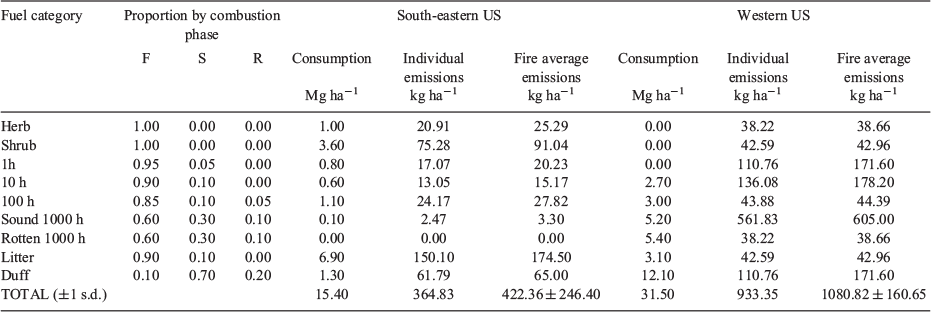
|
Discussion
The online EF database, SERA, was designed as a clearinghouse for field and laboratory-based EFs for Canada and the US. By recording existing EFs by fuel type, MCE and burn type, the tool supports summaries of EFs for use in emissions inventories and wildland fire management. Our sample calculations for SE pine and W pine sites, presented in Table 7, demonstrate that EFs summarised by combustion phase can lead to substantially different emissions estimates than fire-average EFs in certain fuel types. For example, consumption in SE pine sites is dominated by fuels that burn in the flaming phase of combustion. Applying specific EFs for flaming, smouldering and residual smouldering combustion produced a much lower estimate of total PM2.5 emissions than the fire-average EF value. In contrast, the W pine site was dominated by coarse wood and duff, and both approaches produced a comparable estimate of total PM2.5 emissions.
As more EFs are compiled by combustion phase and fire type (e.g. flaming v. smouldering, prescribed v. wildfire), some pollutants that are highly dependent on combustion phase or fire type (e.g. CO, CH4 and PM2.5) may be better characterised to assist with smoke management techniques that identify fuels likely to burn in short- and long-term smouldering combustion and mitigate smoke impacts. Flaming-phase EFs are more represented in SERA than are smouldering and residual smouldering EFs, but in certain vegetation and fuel types, long-term smouldering can be the largest contributor to pollutant emissions and pose the greatest smoke management challenge. The SERA database also offers a standard clearinghouse for new pollutants that are just being documented in wildland smoke, including a wide range of non-methane organic gases, including volatile organic compounds and other air toxins (Urbanski 2014; Koss et al. 2018). It also could be expanded to support EFs in other parts of the world and adapted to incorporate other variables, such as trace indicators of low-heat and high-heat pyrolysis (Gilman et al. 2015; Sekimoto et al. 2018).
Summarising pollutants in our database by fuel type, burn type and combustion phase revealed several data gaps and a bias in the type of measurements collected to date. Across all pollutants in the database, most EFs were measured during the flaming phase of combustion. Given that some pollutants, such as PM2.5, CO, CH4 and a wide range of NMOCs, are more concentrated in smoke produced in short- and long-term smouldering combustion, a greater emphasis on EF characterisation during these phases is needed. For local smoke management applications including prescribed burning support, there is a particular need to characterise smoke from residual smouldering combustion of coarse wood and duff (Strand et al. 2012; Urbanski 2013). However, smoke from residual smouldering is generally not entrained in smoke plumes and does not affect regional air quality (Ottmar 2014; Urbanski 2014). Greater understanding of the relative contribution of flaming and short-term smouldering for lofted emissions is also needed; this is difficult to determine without source characterisation of what is actually consumed.
In many past summaries of best available EFs, pollutant EFs were summarised by major vegetation and/or region. However, the lack of relationship between some pollutant EFs and fuel type is notable, and suggests that major vegetation or fuel type is not always an important factor in emissions production. Other studies have also demonstrated a similarity in pollutant EFs across distinctly different ecosystems and fuel complexes, and have suggested that fire environment (fuel moisture, wind, fire behaviour) may be much more relevant to emissions production than fuel type. For example, Yokelson et al. (2013) noted that pollutant EFs from markedly different ecosystems (semiarid shrublands and western coniferous canopy fuels) had similar pollutant emissions. In a recent study of western wildfire plumes, Liu et al. (2017) reported much higher PM2.5 EFs than those summarised for prescribed burning, and suggested that differences might be attributed to greater availability of coarse wood and organic soils for consumption during summer wildfire seasons (also see Urbanski 2013). May et al. (2014) found that dilution and fuel moisture influenced higher organic aerosol EF values in laboratory burns v. field measurements during the third Fire Laboratory At Missoula Experiment (FLAME-III) experiments. Finally, Chen et al. (2010) investigated the effects of fuel moisture on various fuel components (e.g. duff, litter, soil, leaves, stems) in laboratory burns and reported increased emissions factors of incompletely oxidised C and N species, such as carbon monoxide (CO) and ammonia (NH3) with higher fuel moisture content.
Although substantial advances have been made with instrumentation and characterisation of pollutant emissions in wildland smoke, the science of predicting smoke production, dispersion and chemistry is still rapidly developing. To date, providing best-estimate EFs for smoke management and emissions inventories is challenged by data gaps, inconsistencies in measurement platforms and uncertainty in how EFs should be summarised by vegetation, fuel type and other explanatory variables. In compiling and reviewing the EF literature for SERA, we were challenged by the inconsistencies and redundant reporting of many emissions studies. Many potential records either could not be used to generate best-estimate EFs or required careful parsing to resolve inconsistencies. These included: (1) inconsistency in EF units including g kg−1, lb ton−1, mol kg−1, ppm, g kg−1-C and emission ratios with a trace gas such as CO2 or CO; (2) considerable variability in source characterisation from cursory descriptions of broad vegetation types (e.g. from airborne plume sampling of active wildfires) and detailed descriptions of vegetation and fuels, including moisture content and composition (e.g. some laboratory burns); (3) redundancy in reported datasets across papers (e.g. Hegg et al. (1990); Radke et al. (1990, 1991); Laursen et al. (1992)); (4) applicability of reported EFs from experimental studies that varied fuel moistures or immersed fuels in water to improve extractions of target pollutants (e.g. Chen et al. (2010); Grandesso et al. (2011)); and (5) differences in reported EFs due to instrumentation (e.g. Aurell and Gullett 2013).
To facilitate adding future studies to SERA, we recommend reporting EFs in g kg−1 of dry weight biomass consumed, in addition to location, major vegetation type, fuel category, MCE, measurement platform, fuel moisture content and burn type. Additional fields that would be optimal to report are listed in Tables 1 and 2. We also recommend reporting EF data for each burn experiment, rather than averages of multiple experiments.
Tables 4–6 present a synthesis of available EF data split by vegetation types and combustion phase, with the goal of updating the information employed in land manager tools such as Consume, FOFEM and the BlueSky smoke modelling framework. To compare our values with those previously used for emissions predictions and reported in other EF reviews, Table 8 presents comparisons of SERA summary EF values with those reported in Andreae and Merlet (2001), the 2001 Smoke Management Guide (Hardy et al. 2001), Yokelson et al. (2013) and Urbanski (2014). Across forested systems, the SERA-based analysis yielded a somewhat higher PM2.5 EF of 25.29 g kg−1 for SE conifer than did the other studies, which ranged from 6 to 17 g kg−1. This is due to higher reported EF values from Aurell and Gullett (2013), Strand et al. (2012) and Robertson et al. (2014). Otherwise, in general, the EFs range from a factor of 3 to an order of magnitude in variability across these references, with the SERA-based data falling within the bounds of previous summaries.
Although much emphasis is placed on selecting appropriate EFs for estimating pollutant emissions, it is important to place EFs in the context of their importance in estimating wildland fire emissions and dispersion. Application of best available EFs and their associated uncertainty is one of many steps in smoke prediction, including fuel characterisation, the amount and type of fuels consumed (e.g. fine wood v. coarse wood), the proportion of lofted smoke and factors influencing dispersion. In ensemble modelling of smoke production and dispersion, uncertainty around EF estimation is eclipsed by even larger uncertainty in fire area (factor of 4; Larkin et al. (2012, 2014)), fuel loading (factor of 2; Drury et al. (2014)), consumption estimation (23%; Drury et al. (2014)) and atmospheric transport (100% uncertainty; Garcia-Menendez et al. (2013)). The side panel calculation of emissions by fuel component and combustion phase shows a 20 to 50% difference in emissions estimation based on a single standard deviation of the EF estimate variability. This variability is easily on par with that of fuel consumption, but is still eclipsed by other factors such as the fire size estimate, fuel loading and atmospheric transport. EFs can vary from a factor of 5 to more than an order of magnitude (Figs 2 and 3). The side panel calculations illustrate that EF variability remains significant, but that having more detailed information regarding fuels and combustion constrains variability to levels less than other components in the emission calculation stream.
Conclusion
The present study revealed several important data gaps in EF records. Across all pollutants, more studies are needed for wildfires, residual smouldering and organic soils, and for specific vegetation types including grasslands, northern forests and broadleaf deciduous forests. Wildfires are a large wildland fire emission source regionally, and across the US account for ~16% of the total PM2.5 in the US EPA National Emissions Inventory (US Environmental Protection Agency 2018). The work of Liu et al. (2017) suggests that PM1 EFs from wildfires are more than twice those of prescribed fires because wildfires tend to burn more dead and/or down fuels and live, moist canopy fuels. Grasslands and other rangelands comprise a significant portion of the continental US, and historically have a frequent fire return interval. Fuel loadings can vary greatly depending on seasonality and drought conditions. Duff and organic soils can consume more than an order of magnitude more fuel per unit area than most other fuel types (Akagi et al. 2011), and can smoulder and emit for many months after ignition.
Finally, trace gases and aerosols such as non-methane organic compounds are underrepresented in the database. The detection of trace gas and aerosol species has been improving dramatically in recent years – newer studies are identifying more and more pollutant species (e.g. Akagi et al. 2011; Urbanski 2014; Liu et al. 2017; Koss et al. 2018), while other studies are investigating different measurement techniques for the same species (e.g. Aurell and Gullett 2013; Aurell et al. 2015; Koss et al. 2018). Accounting for this and assessing EF data in light of new technologies and measurement techniques may be necessary in the future. Furthermore, several factors greatly affect EF measurement, such as how these trace gases and aerosols react in the atmosphere (e.g. semi-volatile species condensing and volatilising), effects of heat and dilution on the in-plume chemistry and also where measurements are made (e.g. close to the source, close to the ground, airborne, etc.). These are all items to consider when analysing EF data.
Conflicts of interest
The authors declare no conflicts of interest.
Acknowledgements
The authors acknowledge the National Wildfire Coordinating Group Smoke Committee and the US Forest Service PNW Research Station for funding this work. This paper represents results of the second year of work on a 3-year project, ‘Standardising North American Fire Emission Factors for use in Wildland Fire Applications’. We recognise the authors from Lincoln et al. (2014) and the foundational work they did compiling decades of emission factor data from their Strategic Environmental Research and Development Program (SERDP) project, and thank David Weiss for his careful review of the Smoke Emissions Repository Application. Three anonymous reviewers greatly improved this manuscript through their detailed and constructive feedback. Finally, Samantha DeAbreu helped us bring consistency and organisation to the hundreds of trace gas species.
References
Akagi SK, Yokelson RJ, Wiedinmyer C, Alvarado MJ, Reid JS, Karl T, Crounse JD, Wennberg PO (2011) Emission factors for open and domestic biomass burning for use in atmospheric models. Atmospheric Chemistry and Physics 11, 4039–4072.| Emission factors for open and domestic biomass burning for use in atmospheric models.Crossref | GoogleScholarGoogle Scholar |
Albini FA, Reinhardt ED (1997) Improved calibration of a large fuel burnout model. International Journal of Wildland Fire 7, 21–28.
| Improved calibration of a large fuel burnout model.Crossref | GoogleScholarGoogle Scholar |
Andreae MO, Merlet P (2001) Emissions of trace gases and aerosols from biomass burning. Global Biogeochemical Cycles 15, 955–966.
| Emissions of trace gases and aerosols from biomass burning.Crossref | GoogleScholarGoogle Scholar |
Aurell J, Gullett BK (2013) Emission factors from aerial and ground measurements of field and laboratory forest burns in the southeastern U.S.: PM2.5, black and brown carbon, VOC, and PCDD/PCDF. Environmental Science & Technology 47, 8443–8452.
| Emission factors from aerial and ground measurements of field and laboratory forest burns in the southeastern U.S.: PM2.5, black and brown carbon, VOC, and PCDD/PCDF.Crossref | GoogleScholarGoogle Scholar |
Aurell J, Gullett BK, Tabor D (2015) Emissions from southeastern U.S. grasslands and pine savannas: comparison of aerial and ground field measurements with laboratory burns. Atmospheric Environment 111, 170–178.
| Emissions from southeastern U.S. grasslands and pine savannas: comparison of aerial and ground field measurements with laboratory burns.Crossref | GoogleScholarGoogle Scholar |
Chen LWA, Verburg P, Shackelford A, Zhu D, Susfalk R, Chow JC, Watson JG (2010) Moisture effects on carbon and nitrogen emission from burning of wildland biomass. Atmospheric Chemistry and Physics 10, 6617–6625.
| Moisture effects on carbon and nitrogen emission from burning of wildland biomass.Crossref | GoogleScholarGoogle Scholar |
Drury SA, Larkin N, Strand TT, Huang S, Strenfel SJ, Banwell EN, O’Brien TE, Raffuse SM (2014) Intercomparison of fire size, fuels, fuel consumption, and smoke emissions estimates in the 2006 Tripod Fire, Washington, USA. Fire Ecology 10, 56–83.
| Intercomparison of fire size, fuels, fuel consumption, and smoke emissions estimates in the 2006 Tripod Fire, Washington, USA.Crossref | GoogleScholarGoogle Scholar |
Garcia-Menendez F, Hu Y, Odman MT (2013) Simulating smoke transport from wildland fires with a regional-scale air quality model: sensitivity to uncertain wind fields. Journal of Geophysical Research, D, Atmospheres 118, 6493–6504.
| Simulating smoke transport from wildland fires with a regional-scale air quality model: sensitivity to uncertain wind fields.Crossref | GoogleScholarGoogle Scholar |
Gilman JB, Lerner BM, Kuster WC, Goldan PD, Warneke C, Veres PR, Roberts JM, de Gouw JA, Burling IR, Yokelson RJ (2015) Biomass burning emissions and potential air quality impacts of volatile organic compounds and other trace gases from fuels common in the US. Atmospheric Chemistry and Physics 15, 13915–13938.
| Biomass burning emissions and potential air quality impacts of volatile organic compounds and other trace gases from fuels common in the US.Crossref | GoogleScholarGoogle Scholar |
Grandesso E, Gullet B, Touati A, Tabor D (2011) Effect of moisture, charge size, and chlorine concentration on PCDD/F emissions from simulated open burning of forest biomass. Environmental Science & Technology 45, 3887–3894.
| Effect of moisture, charge size, and chlorine concentration on PCDD/F emissions from simulated open burning of forest biomass.Crossref | GoogleScholarGoogle Scholar |
Hardy CC, Ward DE, Einfield W (1992) PM2.5 emissions from a major wildfire using a GIS: rectification of airborne measurements. In ‘Proceedings of the 29th annual meeting of the PNW International Section, Air and Waste Management Association’, 11–13 November 1992, Bellevue, WA. Air and Waste Management Association. (Pittsburgh, PA)
Hardy CC, Conard SG, Regelbrugge JC, Teesdale DT (1996) Smoke emissions from prescribed burning of southern California chaparral. US Forest Service Pacific Northwest Research Station, PNW-RP-486. (Portland, OR)
Hardy CC, Ottmar RD, Peterson JL, Core JE, Seamon P (2001) ‘Smoke management guide for prescribed and wildland fire’, 2001 edn. National Wildfire Coordinating Group, Fire Use Working Team, NFES 1279. (Boise, ID)
Hegg DA, Radke LF, Hobbs PV, Rasmussen RA, Riggan PJ (1990) Emissions of some trace gases from biomass fires. Geophysical Research 95, 5669–5675.
Hu Y, Fernandez-Anez N, Smith TEL, Rein G (2018) Review of emissions from smouldering peat fires and their contribution to regional haze episodes. International Journal of Wildland Fire 27, 293–312.
| Review of emissions from smouldering peat fires and their contribution to regional haze episodes.Crossref | GoogleScholarGoogle Scholar |
Koss AR, Sekimoto K, Gilman JB, Selimovic V, Coggon MM, Zarzana KJ, Yan B, Lerner BM, Brown SS, Jimenez JL, Krechmer J, Roberts JM, Warneke C, Yokelson RJ, de Gouw J (2018) Non-methane organic gas emissions from biomass burning: identification, quantification, and emission factors from PTR-ToF during the FIREX 2016 laboratory experiment. Atmospheric Chemistry and Physics 18, 3299–3319.
| Non-methane organic gas emissions from biomass burning: identification, quantification, and emission factors from PTR-ToF during the FIREX 2016 laboratory experiment.Crossref | GoogleScholarGoogle Scholar |
Larkin NK, O’Neill SM, Solomon R, Raffuse S, Strand T, Sullivan DC, Krull C, Rorig M, Peterson J, Ferguson SA (2009) The BlueSky smoke modeling framework. International Journal of Wildland Fire 18, 906–920.
| The BlueSky smoke modeling framework.Crossref | GoogleScholarGoogle Scholar |
Larkin NK, Strand TM, Drury SA, Raffuse SM, Solomon RC, O’Neill SM, Wheeler N, Huang S, Rorig M, Hafner HR (2012) Phase 1 of the smoke and emissions model intercomparison project (SEMIP): creation of SEMIP and evaluation of current models. Final report to the Joint Fire Science Program, Project #08–1-6–10. (Boise, ID)
Larkin NK, Raffuse SM, Strand TM (2014) Wildland fire emissions, carbon, and climate: U.S. emissions inventories. Forest Ecology and Management 317, 61–69.
| Wildland fire emissions, carbon, and climate: U.S. emissions inventories.Crossref | GoogleScholarGoogle Scholar |
Laursen KK, Hobbs PV, Radke LF (1992) Some trace gas emissions from North American biomass fires with an assessment of regional and global fluxes from biomass burning. Journal of Geophysical Research 97, 20687–20701.
| Some trace gas emissions from North American biomass fires with an assessment of regional and global fluxes from biomass burning.Crossref | GoogleScholarGoogle Scholar |
Lincoln E, Hao W, Weise DR, Johnson TJ (2014) Wildland fire emission factors database. Forest Service Research Data Archive. (Fort Collins, CO) https://doi.org/10.2737/RDS-2014-0012
Liu X, Huey LG, Yokelson RJ, Selimovic V, Simpson IJ, Müller M, Jimenez JL, Campuzano-Jost P, Beyersdorf AJ, Blake DR, Butterfield Z, Choi Y, Crounse JD, Day DA, Diskin GS, Dubey MK, Fortner E, Hanisco TF, Hu W, King LE, Kleinman L, Meinardi S, Mikoviny T, Onasch TB, Palm BB, Peischl J, Pollack IB, Ryerson TB, Sachse GW, Sedlacek AJ, Shilling JE, Springston S, St Clair JM, Tanner DJ, Teng AP, Wennberg PO, Wisthaler A, Wolfe GA (2017) Airborne measurements of western U.S. wildfire emissions: comparison with prescribed burning and air quality implications. Journal of Geophysical Research. Atmospheres 122, 6108–6129.
| Airborne measurements of western U.S. wildfire emissions: comparison with prescribed burning and air quality implications.Crossref | GoogleScholarGoogle Scholar |
MACTEC Federal Programs (2004) Emission reduction techniques for agricultural burning and wildland fire: a guide to the final work products. Prepared for the Fire Emissions Joint Forum, Western Regional Air Partnership (WRAP). (Durham, NC)
May AA, McMeeking GR, Lee T, Taylor JW, Craven JS, Burling I, Sullivan AP, Akagi S, Collett JL, Flynn M, Coe H, Urbanski SP, Seinfeld JH, Yokelson RJ, Kreidenweis SM (2014) Aerosol emissions from prescribed fires in the United States: a synthesis of laboratory and aircraft measurements. Journal of Geophysical Research, D, Atmospheres 119, 11826–11849.
| Aerosol emissions from prescribed fires in the United States: a synthesis of laboratory and aircraft measurements.Crossref | GoogleScholarGoogle Scholar |
Miller C, O’Neill SM, Rorig M, Alvarado E (2019) Air quality challenges of prescribed fire in complex terrain and the wildland urban interface surrounding Bend, Oregon. Atmosphere 10, 515
| Air quality challenges of prescribed fire in complex terrain and the wildland urban interface surrounding Bend, Oregon.Crossref | GoogleScholarGoogle Scholar |
Ottmar RD (2014) Wildland fire emissions, carbon, and climate: modeling fuel consumption. Forest Ecology and Management 317, 41–50.
| Wildland fire emissions, carbon, and climate: modeling fuel consumption.Crossref | GoogleScholarGoogle Scholar |
Peterson J, Lahm P, Fitch M, George M, Haddow D, Melvin M, Hyde J, Eberhardt E (2018) NWCG Smoke Management Guide for Prescribed Fire, National Wildfire Coordinating Group, PMS 420–2, NFES 001279. (Boise, ID)
Prichard SJ (2007) Consume user’s guide. Pacific Wildland Fire Sciences Laboratory USDA Forest Service. (Seattle, WA) Available at http://www.fs.fed.us/pnw/fera/research/smoke/consume/consume30_users_guide.pdf [accessed 22 April 2019]
Prichard SJ, Kennedy MC, Wright CS, Cronan JB, Ottmar RD (2017) Predicting forest floor and woody fuel consumption from prescribed burns in southern and western pine ecosystems of the United States. Forest Ecology and Management 405, 328–338.
| Predicting forest floor and woody fuel consumption from prescribed burns in southern and western pine ecosystems of the United States.Crossref | GoogleScholarGoogle Scholar |
Radke LF, Lyons DA, Hobbs JH, Hegg PV, Sandberg DV, Ward DE (1990) Airborne monitoring and smoke characterization of prescribed fires in forest lands in Western Washington and Oregon: final report. USDA Forest Service, PNW Research Station, General Technical Report PNW-GTR-251. (Portland, OR)
Radke LF, Hegg DA, Hobbs PV, Nance JD, Lyons JH, Laursen KK, Weiss RE, Riggan PJ, Ward DE (1991) Particulate and trace gas emissions from large biomass fires in North America. In ‘Global biomass burning: atmospheric, climatic and biospheric implications’. (Ed. JS Levine) pp. 209–224. (MIT Press: Cambridge, MA)
Reinhardt ED, Keane RE, Brown JK (1997) First order fire effects model: FOFEM. USDA Forest Service Rocky Mountain Research Station, GTR-INT-344. (Ogden, UT)
Robertson KM, Hsieh YP, Bugna GC (2014) Fire environment effects on particulate matter emission factors in southeastern US pine-grasslands. Atmospheric Environment 99, 104–111.
| Fire environment effects on particulate matter emission factors in southeastern US pine-grasslands.Crossref | GoogleScholarGoogle Scholar |
Sekimoto K, Koss AR, Gilman JB, Selimovic V, Coggon MM, Zarzana KJ, Yuan B, Lerner BM, Brown SS, Warneke C, Yokelson RJ, Roberts JM, de Gouw J (2018) High- and low-temperature pyrolysis profiles describe volatile organic compound emissions from western US wildfire fuels. Atmospheric Chemistry and Physics 18, 9263–9281.
| High- and low-temperature pyrolysis profiles describe volatile organic compound emissions from western US wildfire fuels.Crossref | GoogleScholarGoogle Scholar |
Strand TM, Larkin NK, Craig KJ, Raffuse S, Sullivan D, Solomon R, Rorig M, Wheeler N, Pryden D (2012) Analyses of BlueSky Gateway PM2.5 predictions during the 2007 southern and 2008 northern California fires. Journal of Geophysical Research 117, D17301
| Analyses of BlueSky Gateway PM2.5 predictions during the 2007 southern and 2008 northern California fires.Crossref | GoogleScholarGoogle Scholar |
Urbanski S (2013) Combustion efficiency and emission factors for wildfire-season fires in mixed conifer forests of the northern Rocky Mountains, US. Atmospheric Chemistry and Physics 13, 7241–7262.
| Combustion efficiency and emission factors for wildfire-season fires in mixed conifer forests of the northern Rocky Mountains, US.Crossref | GoogleScholarGoogle Scholar |
Urbanski S (2014) Wildland fire emissions, carbon, and climate: emission factors. Forest Ecology and Management 317, 51–60.
| Wildland fire emissions, carbon, and climate: emission factors.Crossref | GoogleScholarGoogle Scholar |
US Environmental Protection Agency (2017). 2017 National Emissions Inventory (NEI) Plan. (Washington, DC) Available at https://www.epa.gov/air-emissions-inventories/2017-national-emissions-inventory-nei-plan [accessed 22 April 2019]
U.S. Environmental Protection Agency, Office of Air Quality Planning and Standards (2018). 2014 National Emissions Inventory, version 2, Technical Support Document. (Research Triangle Park, NC) Available at https://www.epa.gov/sites/production/files/2018-07/documents/nei2014v2_tsd_05jul2018.pdf [accessed 19 September 2019].
Ward DE, Hardy CC, Sandberg D, Reinhardt T (1989) Mitigation of prescribed fire atmospheric pollution through increased utilization of hardwood, piles residues, and long-needled conifers. Part III: Emissions Characterization. U.S. Department of Energy, Northwest Research Station, Final Report IAG DA-AI179– 85BP18509. (Portland, OR).
Yokelson RJ, Griffith DWT, Ward DE (1996) Open path Fourier transform infrared studies of large-scale laboratory biomass fires. Journal of Geophysical Research 101, 21067–21080.
| Open path Fourier transform infrared studies of large-scale laboratory biomass fires.Crossref | GoogleScholarGoogle Scholar |
Yokelson RJ, Burling IR, Gilman JB, Warneke C, Stockwell CE, de Gouw J, Akagi SK, Urbanski SP, Veres P, Roberts JM, Kuster WC, Reardon J, Griffith DWT, Johnson TJ, Hosseini S, Miller JW, Cocker DR, Jung H, Weise DR (2013) Coupling field and laboratory measurements to estimate the emission factors of identified and identified trace gases for prescribed fires. Atmospheric Chemistry and Physics 13, 89–116.
| Coupling field and laboratory measurements to estimate the emission factors of identified and identified trace gases for prescribed fires.Crossref | GoogleScholarGoogle Scholar |



